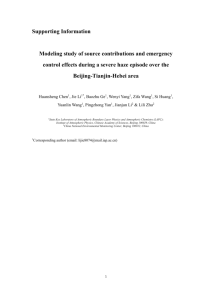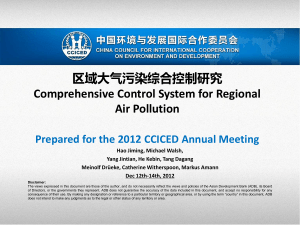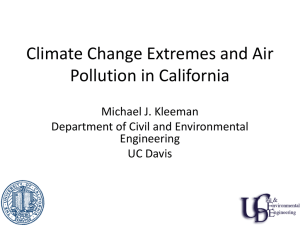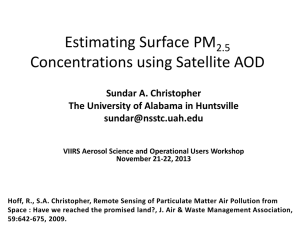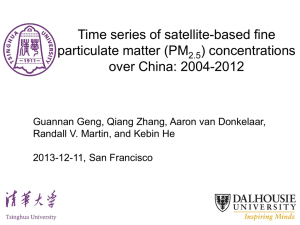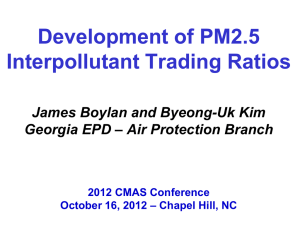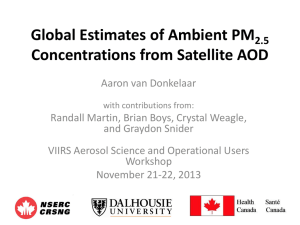Document
advertisement
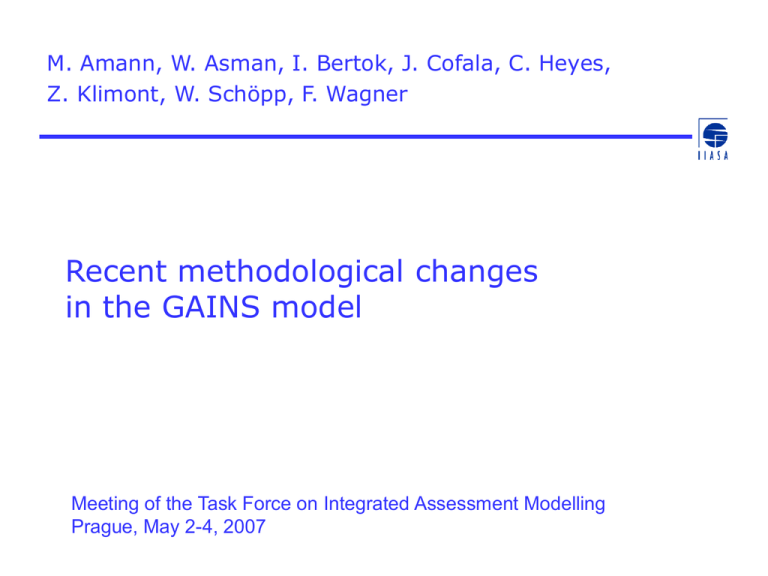
M. Amann, W. Asman, I. Bertok, J. Cofala, C. Heyes, Z. Klimont, W. Schöpp, F. Wagner Recent methodological changes in the GAINS model Meeting of the Task Force on Integrated Assessment Modelling Prague, May 2-4, 2007 Recent methodological changes • Update to the City-delta methodology • RAINS cost curve-based optimization replaced by GAINS measured-based optimization • 5-years meteorological conditions • EC4MACS work plan Changes to the City-delta methodology Changes since December 2006 • New population and city-domain data (“compact” city shapes including ~70% of population) • Target metric: population-weighted PM2.5 concentration for health impact assessment • Refined results from the three urban models • Revised functional relationship • Multi-year meteorology • Modified assumptions on urban emissions “Compact urban shape” for which the urban increment is computed – Prague Compact urban shapes for which the urban increments are computed Paris London Lisbon Krakow Milan Berlin Urban increments computed by the three models for the 5*5 km center grid cell and population-weighted 12 Increment (microgram/m3) 10 8 6 4 2 0 Berlin Krakow Lisbon 5 km * 5 km London Milan Population-weighted Paris Prague Urban increments computed by Chimere, CAMx, RCG, compared with the City-delta regression 14 12 microgram/m3 10 8 6 4 2 0 Berlin Krakow Lisbon Chimere London CAMx RCG Milan City-delta Paris Prague Hypothesis of the City-delta functional relationship D D d c Q Q U U 365 Δc … concentration increment computed with the 3 models α. β … regression coefficients D … city diameter U … wind speed Δq … change in emission fluxes d … number of winter days with low wind speed ie n So fia Br H no el si nk i Li l l e Va To le ul nc on i M enn on e tp s el Av lier i g M ue non n N ch ue en rn W be up rg pe Bi rta el l e C fel he d m ni Ka tz ss el H D al or le tm un M d ila G no en o Ve va Am ne st zia er da Le m id K en By rak dg ow os zc z C Por on to st a Lj nta ub l Za jan ra a go C za or St do oc ba kh o G lm M en an ev e c N hes ot t e tin r P gh St orts am ok m e- ou o t Ki So n-T h ng ut r e st ha nt on m up pto on n H ul l W kg PM2.5/person/yr Urban per-capita emissions by SNAP sector 3.0 2.5 2.0 1.5 1.0 0.5 0.0 SNAP 2 (Domestic) SNAP 3 (Idustry) Snap 7 (Traffic) SNAP 8 (Other mobile sources) 0 Urban increment (microgram PM2.5/m3) Emission density (t/km2) Kingston upon Hull Southampton Stoke-on-Trent Portsmouth Nottingham Manchester Geneve Stockholm Cordoba Zaragoza Ljubljana Constanta Porto Bydgoszcz Krakow Leiden Amsterdam Venezia Genova Milano Dortmund Halle Kassel Chemnitz Bielefeld Wuppertal Nuernberg Muenchen Avignon Montpellier Valenciennes Toulon Lille Helsinki Brno Sofia Wien Emission densities (red) and computed urban increments (blue) 30 25 20 15 10 5 Contribution of long-range transport (blue) and local primary PM emissions (red) to urban PM2.5 35 30 AT BE Bulgaria FI France 20 15 10 5 Assumed mineral and sea salt Urban increment Brest Angers Dijon Avignon Bethune Rennes Saint-Etienne Metz Valenciennes Grenoble Lens Nantes Toulouse Lille Marseille Turku Helsinki Arhus Ostrava Praha Varna Sofia Gent Bruxelles Linz 0 Wien microgram PM2.5/m3 25 Regional background AIRBASE monitoring data for urban background 2004 Assumed mineral and sea salt Urban increment Porto Lisboa Netherlands NO Poland Torun Kielce Radom Czestochowa Gdynia Bialystok Lublin Bydgoszcz Szczecin Gdansk Poznan Wroclaw Krakow Lodz Warszawa Katowice Bergen Oslo Groningen Heerlen Tilburg Dordrecht Leiden Eindhoven Utrecht Gravenhage Rotterdam Amsterdam Italy Kaunas Vilnius Riga Trieste Padova Messina Verona Venezia Catania Bari Firenze Bologna Genova Palermo Torino Napoli Roma Milano microgram PM2.5/m3 Contribution of long-range transport (blue) and local primary PM emissions (red) to urban PM2.5 35 PT 30 25 20 15 10 5 0 Regional background AIRBASE monitoring data for urban background 2004 Contribution of long-range transport (blue) and local primary PM emissions (red) to urban PM2.5 35 Germany GR HU 30 20 15 10 5 Assumed mineral and sea salt Urban increment Debrecen Thessaloniki Dortmund Wuerzburg Zwickau Magdeburg Muenster Halle Osnabrueck Kiel Braunschweig Reutlingen Chemnitz Moenchengladbach Leipzig Karlsruhe Dresden Wuppertal Bonn Hannover Duesseldorf Koeln Muenchen Stuttgart 0 Essen microgram PM2.5/m3 25 Regional background AIRBASE monitoring data for urban background 2004 Assumed mineral and sea salt Urban increment Plymouth Kingston upon Hull Barnsley Gillingham Luton Derby Aldershot Blackpool Preston Southend-on-Sea Swansea Southampton Birkenhead Cardiff Coventry Belfast Stoke-on-Trent Middlesbrough Reading Bournemouth Leicester Portsmouth Edinburgh Brighton Bristol Sheffield Nottingham Liverpool Newcastle-upon-Tyne Glasgow Leeds Manchester Birmingham London microgram PM2.5/m3 Contribution of long-range transport (blue) and local primary PM emissions (red) to urban PM2.5 35 30 United Kingdom 25 20 15 10 5 0 Regional background AIRBASE monitoring data for urban background 2004 Sectoral contributions to background concentrations of primary PM2.5 components from urban sources 18 16 AT BE Bulgaria FI France 14 10 8 6 4 2 Domestic (SNAP 2) Industry (SNAP3) Traffic (SNAP7) Non-road mobile (SNAP 8) Brest Angers Dijon Avignon Bethune Rennes Saint-Etienne Metz Valenciennes Grenoble Lens Nantes Toulouse Lille Marseille Turku Helsinki Arhus Ostrava Praha Varna Sofia Gent Bruxelles Linz 0 Wien microgram PM2.5/m3 12 Domestic (SNAP 2) Industry (SNAP3) Traffic (SNAP7) Non-road mobile (SNAP 8) Plymouth Kingston upon Hull Barnsley Gillingham Luton Derby Aldershot Blackpool Preston Southend-on-Sea Swansea Southampton Birkenhead Cardiff Coventry Belfast Stoke-on-Trent Middlesbrough Reading Bournemouth Leicester 16 Portsmouth Edinburgh Brighton Bristol Sheffield Nottingham Liverpool Newcastle-upon-Tyne Glasgow Leeds Manchester Birmingham London microgram PM2.5/m3 Sectoral contributions to background concentrations of primary PM2.5 components from urban sources 18 United Kingdom 14 12 10 8 6 4 2 0 Summary • Substantial revisions of methodology and input data • Health impact assessment based on population-weighted increments – conservative assumption? • Largest uncertainties associated with quality of urban emission estimates. Large discrepancies cannot be readily explained • More plausible on emissions assumptions improve estimates • Validation hampered by lack of quality-controlled monitoring data • Sensitivity analysis explored implications on optimization results Mathematical formulation of the GAINS optimization Comparison of cost curves Examples for Germany and Greece Germany, SO2, NEC_NAT,2020 800 1000 800 600 400 200 costs-RAINS costs-GAINS 700 Total cost MEur/yr costs-RAINS costs-GAINS 1200 Total cost MEur/yr 600 500 400 300 200 100 340 390 0 660 440 Remaining Emissions kt/yr 1000 800 600 400 200 760 810 860 75 910 Greece, SO2, NEC_NAT,2020 Greece, NOx, NEC_NAT,2020 60 40 20 90 95 100 250 160 Total cost MEur/yr 80 85 Greece, PM2.5, NEC_NAT,2020 180 costs-RAINS costs-GAINS 80 Remaining Emissions kt/yr Remaining Emissions kt/yr 120 100 costs-RAINS costs-GAINS 1200 0 710 costs-RAINS costs-GAINS 140 Total cost MEur/yr Total cost MEur/yr 1400 900 0 290 Total cost MEur/yr Germany, PM2.5, NEC_NAT,2020 Germany, NOx, NEC_NAT,2020 1400 120 100 80 60 40 costs-RAINS costs-GAINS 200 150 100 50 20 0 40 50 60 70 80 Remaining Emissions kt/yr 90 0 140 0 150 160 170 180 190 Remaining Emissions kt/yr 200 210 16 21 26 Remaining Emissions kt/yr 31 Multi-year meteorology Multi-year meteorology • Atmospheric dispersion based on meteorological conditions of 1996, 1997, 1998, 2000, 2003 • Sensitivity analysis with 2003 5-yrs mean 2003 1997 Switzerland Norway Croatia EU-25 EU-27 UK Sweden Spain Slovenia Slovakia Romania Portugal Poland Netherlands Malta Luxembourg Lithuania Latvia Italy Ireland Hungary Greece Germany France Finland Estonia Denmark Czech Rep. Cyprus Bulgaria Belgium Austria Months Loss in statistical life expectancy computed with different meteorological conditions (for 2000) 14 12 10 8 6 4 2 0 5-yrs mean 2003 1997 Switzerland Norway Turkey Croatia EU-27 UK Sweden Spain Slovenia Slovakia Romania Portugal Poland Netherlands Malta Luxembourg Lithuania Latvia Italy Ireland Hungary Greece Germany France Finland Estonia Denmark Czech Rep. Cyprus Bulgaria Belgium Austria Mortality cases in relation to 5-yrs mean Estimates of mortality from ozone for year 2000 emissions for different meteorological conditions 140% 130% 120% 110% 100% 90% 80% 70% 5-yrs mean 2003 1997 Switzerland Norway Turkey Croatia EU-25 EU-27 UK Sweden Spain Slovenia Slovakia Romania Portugal Poland Netherlands Malta Luxembourg Lithuania Latvia Italy Ireland Hungary Greece Germany France Finland Estonia Denmark Czech Rep. Cyprus Bulgaria Belgium Austria km2 of ecosystems with acid deposition above critical loads in relation to 1997 Estimates of unprotected forest area for year 2000 emissions for different meteorological conditions 130% 120% 110% 100% 90% 80% 70% 60% 50% 5-yrs mean 2003 1997 Switzerland Norway Turkey Croatia EU-27 UK Sweden Spain Slovenia Slovakia Romania Portugal Poland Netherlands Malta Luxembourg Lithuania Latvia Italy Ireland Hungary Greece Germany France Finland Estonia Denmark Czech Rep. Cyprus Bulgaria Belgium Austria km2 of ecosystems with nitrogen deposition above critical loads in relation to 1997 Estimates of ecosystem area with excess nitrogen deposition for year 2000 emissions for different meteorological conditions 120% 110% 100% 90% 80% 70% 60% 50% Summary • For EU-27, PM and ozone impacts from 5-yrs meteorology very similar to 1997. Acidification ~10% higher, eutrophication ~5% higher • But different trends in different regions across Europe • Implications on meaures • 2003 produces higher health impacts for PM and ozone EC4MACS European Consortium for Modelling of Air Pollution and Climate Strategies Overview of the 5 years work plan The EC4MACS model system Global/ hemispheric boundary conditions Agriculture Atmosphere Ecosystems Costeffectiveness Impacts CAPRI GEM-E3 Transport Energy European policy drivers TREMOVE POLES PRIMES TM5 EMEP CCE-IMPACTS GAINS BENEFITS FASOM General work plan • 2007: – Methodological improvements • 2008: – Data collection – Feedbacks on methodological improvements • 2009 – Interim assessment – Methodology workshop • 2010 – Uncertainty assessment – Bilateral consultations on input data • 2011 – Final assessment
